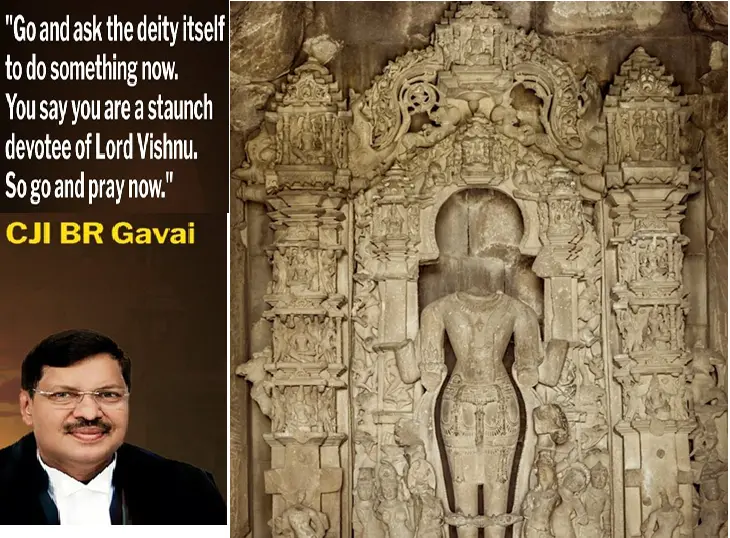
Supreme Court rejects plea to restore Vishnu idol at Khajuraho - CJI Gavai mocks: "Go and ASK the DEITY ITSELF to do something now."
A Temple’s Wound and a Devotee’s Plea
“Pray to the Deity” – On September 16, 2025, India’s Supreme Court dismissed a petition that stirred both spiritual pain and civic debate. The plea, filed by Rakesh Dalal, sought restoration of a 7-foot beheaded idol of Lord Vishnu at the Javari Temple in Khajuraho, Madhya Pradesh, a UNESCO World Heritage site known for its intricate sculptures and sacred architecture.
Dalal’s petition wasn’t just about stone, it was about sentiment. He argued that the mutilated idol, believed to have been damaged during Mughal invasions, had remained in its broken state for centuries despite repeated appeals to the government and the Archaeological Survey of India (ASI). For Dalal and many others, the idol’s condition was not just a historical artifact, it was a spiritual wound that deserved healing.
But the Supreme Court, led by Chief Justice Bhushan Ramkrishna Gavai and Justice K Vinod Chandran, saw the matter differently. They ruled that the restoration of such archaeological finds falls under the jurisdiction of the ASI, not the judiciary. The court labelled the petition as “publicity interest litigation,” a term often used to describe cases that may be more about attention than legal merit.
What truly sparked outrage, however, was the Chief Justice’s remark: “Go and ask the deity itself to do something now. You say you are a staunch devotee of Lord Vishnu. So go and pray now.” This comment, intended perhaps as a light dismissal, was received as deeply insensitive by many Hindus who felt their religious sentiments were being trivialized.
Between Preservation and Worship: Who Decides?
The heart of the issue lies in a complex tug-of-war between historical preservation and religious restoration. The Javari Temple, like many ancient Indian monuments, is protected under ASI guidelines that prioritize maintaining the site’s “authenticity.” This means that any reconstruction, especially of mutilated idols, must be carefully evaluated to avoid altering the original archaeological context.
From the ASI’s perspective, replacing or reconstructing the idol could violate conservation norms. The idol, even in its damaged state, tells a story of time, invasions, and resilience. To alter it might erase that narrative.
But for devotees like Dalal, the idol is not just a historical object, it is a living symbol of faith. The inability to worship a complete form of Lord Vishnu feels like a denial of their spiritual rights. Dalal’s petition argued that the refusal to restore the idol violated the fundamental right to worship, a claim that touches on constitutional freedoms as well as emotional devotion.
This clash between archaeological integrity and religious sentiment is not new. Across India, similar debates have emerged over whether damaged idols should be restored, relocated, or left untouched. The Khajuraho case simply brought this tension into the national spotlight.
Public Reaction: Outrage, Irony, and Reflection
The Supreme Court’s dismissal and the Chief Justice’s remarks triggered a wave of criticism on social media. Many users expressed disbelief that a judge would suggest praying to a broken idol instead of offering legal recourse. Hashtags like #RestoreVishnuIdol and #JusticeForKhajuraho trended briefly, with users calling the comment “tone-deaf” and “hurtful.”
Some Hindu groups issued statements condemning the court’s attitude, arguing that the judiciary should show greater sensitivity toward religious matters. Others pointed out the irony: in a country where courts often intervene in temple management and religious customs, refusing to act on a restoration plea seemed inconsistent.
Yet, there were also voices of reason. Legal experts reminded the public that the court’s role is not to manage heritage sites but to interpret the law. The ASI, as the designated authority, must weigh the historical value of the idol against the desire for restoration. Some conservationists even praised the decision, warning that emotional appeals should not override scientific preservation.
Still, the emotional impact of the court’s words lingered. For many, the phrase “go and ask the deity” felt dismissive not just of the petitioner, but of centuries of faith.
Where Do We Go From Here? Lessons in Faith and Governance
The Khajuraho verdict leaves us with more questions than answers. Should damaged idols in heritage sites be restored for worship? Who gets to decide, the government, the ASI, the courts, or the devotees? And how can institutions balance historical preservation with living faith?
One possible path forward is dialogue. The ASI could consider forming advisory panels that include historians, archaeologists, and religious scholars to evaluate such cases. Public consultations might help bridge the gap between technical rules and emotional needs.
Another lesson lies in judicial communication. Even when dismissing a case, courts must be mindful of how their words resonate with the public. A remark meant in jest or frustration can easily be perceived as disrespectful, especially when it touches on sacred beliefs.
Finally, this case reminds us that India’s heritage is not just about stone and sculpture, it’s about people. Temples like Javari are not museum pieces; they are living spaces of devotion. Their preservation must honour both history and humanity.
Conclusion: “Pray to the Deity” Controversial Verdict: Supreme Court Rejects Plea to Restore Beheaded Vishnu Idol at Khajuraho
The Supreme Court’s rejection of the plea to restore the beheaded Vishnu idol at Khajuraho may be legally sound, but it has opened a deeper conversation about how we treat our sacred past. As India continues to evolve, so must its approach to heritage, one that respects both the silence of stone and the voice of faith.
Also read: Justice Paused: Supreme Court Stays Key Parts of Waqf Amendment Act 2025
Stay informed with the latest news and updates – only on Rapido Updates.
2 thoughts on ““Pray to the Deity” – Controversial Verdict: Supreme Court Rejects Plea to Restore Beheaded Vishnu Idol at Khajuraho”
Comments are closed.